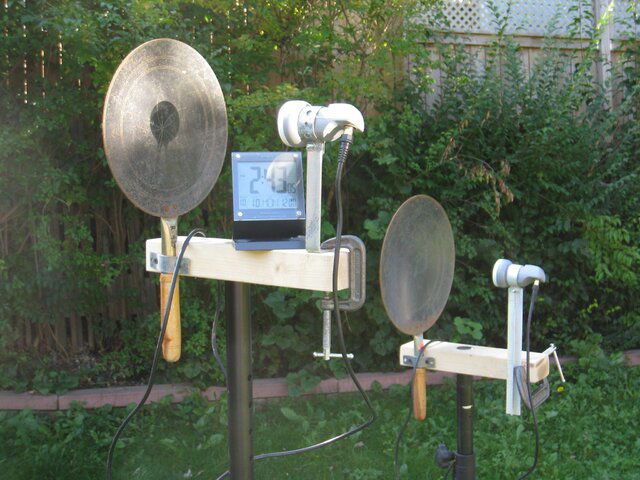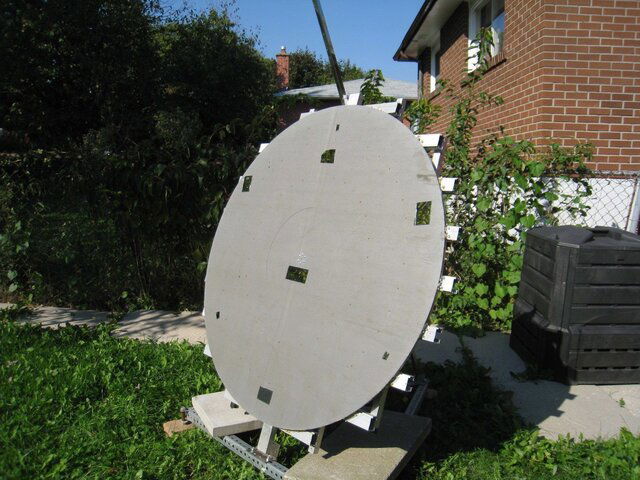Recently I completed some trials in receiving satellite signal after bouncing it off additional surface which has rather long focal length. I built sort of dish, 46" diameter, which is very shallow, less than half inch. I was hoping to put LNB in its focus and catch a signal. Unfortunately, the focus was not well defined (I think some inevitable inaccuracies happened when I made this dish, also the surface of sheet metal was not straight). So I had to use additional small concave surface, for which I used frying pan lid, and later spherical cooking utensils. Finally I was able to receive signals from 97W and 101W simultaneously, using 2 receivers and 2 small TV's. These cooking pans are 10" and 12" and for receiving these satellites they were spaced 28" apart, with one 12" higher than the other. I had to reverse skew, too. (Just wonder how it would be with circular polarization...). Maybe this technique will be useful for people not having direct access to the sky from their home? The "reflector" could be located somewhere in the backyard, and one or more small dishes just below the fascia, or (?) who knows, maybe behind window? I tried to add some photos, but older photos from my previous post popped up, now I see I have to learn more how to use attachments. Luckily I was able to add my avatar. If anybody is interested, please, PM me and I will e-mail photos. Cheers, polgyver
Receiving FTA signal after double reflection
- Thread starter polgyver
- Start date
- Latest activity Latest activity:
- Replies 25
- Views 5K
You are using an out of date browser. It may not display this or other websites correctly.
You should upgrade or use an alternative browser.
You should upgrade or use an alternative browser.
- Status
- Please reply by conversation.
With a circular LNB designed for one reflection, the polarization would be opposite with two reflections, so you'd need an LNB built to accomodate that (they sell such a thing for toroidal-Gregorian dishes) in order to use it with a subscription receiver. If you were using it with an FTA receiver (not that there's much left worth doing so), it wouldn't matter whether you had the "correct" polarity or not.
Yes, I got S close to 60 from the 12" "dish", and 40 something from 10".Does it work?
how were you able to find the focal point of the big dish? trial and error, curvature calculations or a bit of both? great stuff
Before trial with double system, I used 18" dish to roughly locate the place. I also used digital inclinometer (bought in Lee Valley store) for setting the angle of big dish (for Toronto, 97W has altitude 36.4 degree, so I set the big dish at 18.2 to get the reflected rays parallel to ground> Later, I used data from Naval Observatory for info about Sun and a few mirrors to locate the focus. Still later, I raised the big dish as the speaker stands holding small (secondary) dishes could not be lowered enough. Thanks for a friendly acceptance of these tinkering !how were you able to find the focal point of the big dish? trial and error, curvature calculations or a bit of both? great stuff
Thanks for words of appreciation. The idea of making a reflecting surface having very remote focus came to me when I was watching on History Channel a program about architectural "disasters", one was about a building covered with metal sheets which reflected Sun rays into other peoples' houses or apartments. The flat dish I made has a serious flaw : its focal length can not be changed. Now I plan to make reflective surface consisting of 7 round metal plates where the 6 around the central one could be "tuned" or regulated by bolts. With such a concentrator, the focal length could be changed. Instead of "focus" there would be an area with 7-fold intensity of signal wave. Perhaps it would suffice to receive reliable FTA signal on secondary small (18" or smaller) dish. Of course the frame holding these 7 plates should be very stable, especially if focal length would be about 50' or - maybe? - even to 100' (30 m). I also knew about KECK telescope in Hawaii, consisting of 36 mirrors, each sized 1 m, connected with precise hydraulics driven by fast computers - this thing is truly amazing!Thats amazing! Thanks for sharing!
Essentially, yes. Thanks for attachment. Very interesting. Now I know why my Googling ("remote" focus; "very long focal length") did not bring relevant hits. I should have used this term: passive repeater. However, there is a difference. These massive structures are built to reflect waves. No mention about concentrating, focusing nor convergence. Regards, polgSo essentially a "passive repeater"?
Yes, if you refer to my plans for making a cluster of 7 flat round circles (dishes) where all except the central one can be adjusted to reflect light (and other electromagnetic waves) to one common area (secondary dish focused on LNB). 7-fold radiation, even from full Sun, would not do harm to ships attacking Archimedes' city, though ... Your comparison helped me imagine a crowd of hundreds of people holding mirrors and focusing solar light on enemy's boats... and the next analogy is quite contemporary : a solar array of perhaps thousands of flat mirrors on heliostats in Ivanpah Dry Lake, Mojave is presently being built. It makes me wonder if these flat mirrors would also create "sweet spots" of reflected satellite signals, hovering in space in the area of light receiving tower. Probably, given the multiplying effect, the "sweet spots" would have energy density much greater than normally achieved in the focus of typical satellite dish. I think the heliostats would be immobilized during night hours, thus focusing highly concentrated satellite rays in steady place. Would this high energy spot damage or "overdrive" any LNB held there? Sorry, I guess I deviated from the main topic, perhaps it could make a theme of separate post. Cheers, Polgsort of an FTA version of Archimedes death ray
I tried "to keep you in the loop", however, somehow I made a mistake in posting photos : instead of sticking to this thread, I inadvertently posted them as a new thread, "Double reflection photos" where my initial description of settings is missing. I wonder if these now 2 threads could be "fused" together to make one?Great out of the box thinking, Polgyver. Keep us in the loop.
Mike
- Status
- Please reply by conversation.
Similar threads
- Replies
- 19
- Views
- 898
- Replies
- 6
- Views
- 743
- Replies
- 5
- Views
- 280
- Replies
- 0
- Views
- 852
Users Who Are Viewing This Thread (Total: 0, Members: 0, Guests: 0)
Who Read This Thread (Total Members: 1)
Latest posts
-
-
H
-
H





